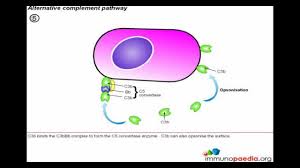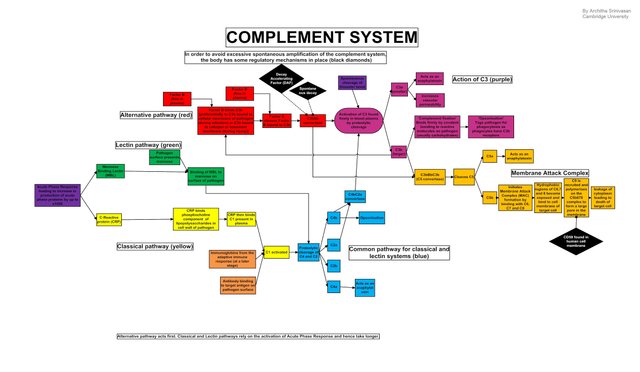**THE COMPLEMENT SYSTEM - A Mechanism of innate immunity**
Most microorganisms on the human body are bacteria and they usually colonized specific site. Sometimes these organisms compete with disease-causing organisms and at other times they have the ability to produce opportunistic infection. The ability of the host to resist such infections depends on a constant defense against microbial colonization or invasion. This ability arises from both innate and adaptive defense mechanisms.
The complement system plays an important role in innate immune response, although there are several mechanisms such as phagocytosis, fever, production cytokines etc involved. Let us by discussing what complement system really means,
complete system is a system of plasma proteins that can be activated directly by pathogens or indirectly by the pathogen-bound antibody, the reaction that appears on the surface of the active component and pathogens with different functions.
The complement system is one of the major mechanisms by which pathogen recognition is converted into an effective host defense against initial infection.
How does the consequences of the complement activated?
It generates large numbers of activated complement proteins that bind covalent to pathogens, opsonizing them for engulfment by phagocytes bearing receptors for complement.
The terminal complement components damage a particular bacteria by establishing a pore in the bacterial membrane.
- The small fragment proteins act as chemo-attractants to recruit more phagocytes to the site of complement activation and also to activate these phagocytes.
Although there some major function of the complement system.
What are the major functions of the complement system?
- It is control of inflammatory reaction and chemotaxis.
- It acts as clearance of the immune complexes.
- It also serves as cellular activation and antimicrobial defense.
- It is major effectors in immune- pathological diseases.

source
There are three pathway but i will like to discuss on alternative pathway today,
2.Alternative Pathway alternative pathway does not need Ag-Ab complex for the introduced of the complement pathway. It is introduced by cell surface components that is foreign to the host. These surface molecules may be lipopolysaccharide, endotoxin, etc.
When a bacterium go into the host body, as a result of inflammation, complements extend towards the site, where C3 molecules constantly touch antigen and become active. In this pathway, serum C3 containing an strong thioester bond undergoes slow generated hydrolysis to give C3a and C3b. C3b binds the surface of foreign cell and whereas binds to another serum protein called factor B. the factor B bring the site which serves as the surface for enzymatically active serum protein D. Then factor D split B into Ba and Bb forming C3 convertase (C3bBb). C3 convertase then forms C5 convertase which recently forms a MAC as in classical pathway.

source
the circulating lectin (MBL) binds to mannose remains on glycoprotein’s or carbohydrates on the surface of microorganisms. Microorganisms inducing MBL pathway are bacteria, such as, Neisseria, Listeria and Salmonella strains, some fungi and many viruses including HIV-1. MBL is an acute phase protein which It’s concentration increases during inflammation. The lectin acknowledges and binds the carbohydrate of the accurate cell which then activates complements.

SOURCE
Thanks for taken your time to readout this post. God bless you abondantly.
